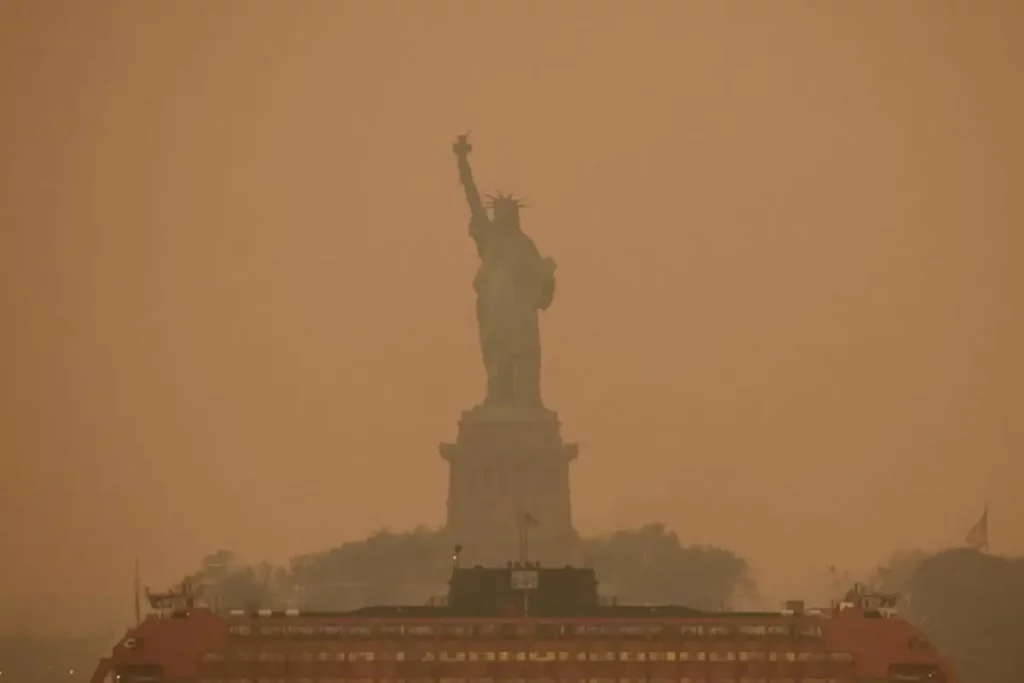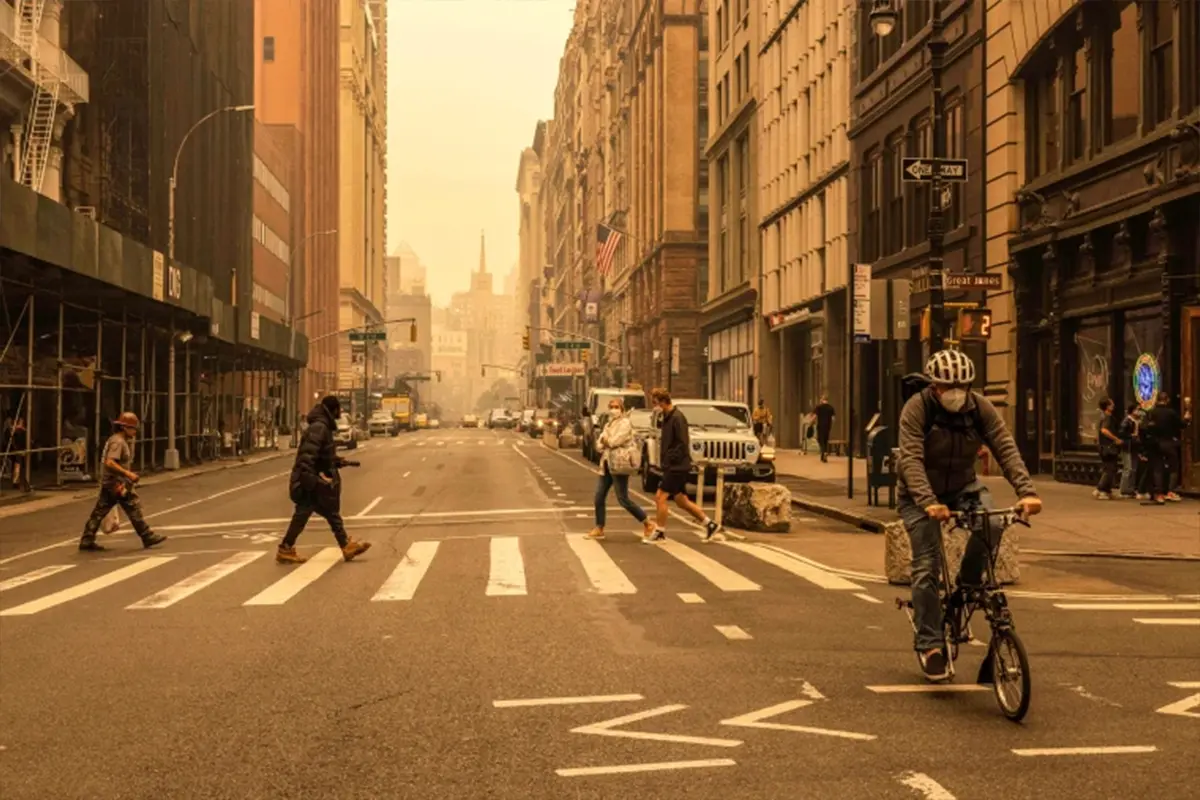Experts have expressed concern about the potential impact of Canadian wildfires on two species in particular: the Whooping Crane, which is found in Alberta, and the Wood Poppy
The Whooping Crane is one of the most endangered birds in North America
The Whooping Crane, and the Wood Poppy, which are found in Ontario, are particularly vulnerable to wildfires, and the loss of either species could have an impact on the local ecosystem.
The Whooping Crane is one of the most endangered birds in North America, with only a few hundred individuals remaining in the wild. It is a long-lived species that requires large areas of undisturbed wetland habitat to breed, feed, and roost. Wildfires can destroy these habitats, making it difficult for the species to survive. The loss of the Whooping Crane would have an impact on the ecosystem, as the species plays a role in maintaining the balance of wetland ecosystems.
Wildfires can destroy the Wood Poppy’s habitat
The Wood Poppy is a delicate plant that is found in Ontario. It is a rare species that is only found in a few locations in the province. Wildfires can destroy the Wood Poppy’s habitat, making it difficult for the species to survive. The loss of the Wood Poppy would not only impact the plant itself but the entire local ecosystem as well. The plant provides food and habitat for a range of insects and other animals, and its loss could have far-reaching consequences for the entire ecosystem.
The potential loss of these species is a stark reminder of the impact that wildfires can have on our natural world. The destruction of habitats due to wildfires can have a cascading effect on the entire ecosystem, leading to the loss of species and the disruption of ecological processes.
The fires have caused disruptions to the industry, with production facilities and pipelines being damaged or shut down due to safety concerns. This has not only affected the economy of the province but also had ripple effects on industries and markets around the world that rely on Canadian oil and gas exports.
Canadian wildfires: the series of an unfortunate event
Across nine of Canada’s 13 provinces and territories, uncontrollable blazes have ravaged millions of acres of forest, destroyed hundreds of structures, displaced over 100,000 people from their homes, and enveloped cities in eerie clouds of toxic smoke. Canada, with its 895 million acres of forest that cover about one-third of the total land area, experiences wildfires every year. However, this year’s wildfires have been particularly extensive, numerous, and intense.
Officials have noted that the outbreak of so many blazes across the country at this time of year is ‘not normal’, and the worst may be yet to come. If the rate of fire activity continues at its current pace, the country is on track to experience the worst wildfire season in its recorded history.
The impact of Canadian wildfires on the natural world, communities, and economies
The loss of millions of acres of forest is disrupting the ecosystem, affecting everything from soil quality to the populations of animals that call these forests home. The destruction of homes and communities has left many people without shelter or a place to call home, leading to widespread disruption and uncertainty. The economic impact of the fires has also been significant, with industries such as tourism and agriculture being hit hard.
Wednesday 7th of June 2023 – New York skies covered in orange haze
The skies over New York City were shrouded in an unexpected haze. As it turns out the source of the phenomenon was plumes of smoke from the raging forest fires in Canada. As the smoke and pollutants have been carried far and wide, affecting the air quality and health of people in neighboring countries. The winds had carried the haze first to Ottawa and Toronto, and then directly into many of the major population centers of the US east coast.
A natural disaster that the country of Canada has been experiencing for years, becoming increasingly severe and costly. In fact, they are now considered the second most expensive disaster in the country, surpassed only by flooding. The fires are fueled by drought, high temperatures and strong winds. With the carbon emissions from these fires greatly contributing to global warming and exacerbating the climate crisis.
The wildfires raging across Canada have been described by federal officials as one of the worst fire seasons the country has ever experience
The sheer scale and severity of the fires are a sobering reminder of the impact of climate change on our natural world and communities. The fires have ravaged vast swaths of forests, leaving a trail of destruction in their wake. The impact of these fires goes far beyond Canada, as the smoke and pollutants have been carried far and wide, affecting the air quality and health of people in neighboring countries.
The impact on the natural world has been devastating. The fires have destroyed millions of acres of forests, with some estimates suggesting that the total area burned may exceed 8 million acres. The loss of habitat and vegetation will have far-reaching consequences for the ecosystem, affecting everything from soil quality to the populations of animals that call these forests home. The fires have also led to the displacement of many species, further disrupting the balance of nature.
Pollution pandemic: the reality of a worsening air quality due to the wildfires in Canada
The air quality in many major cities has been severely impacted by the smoke from a fire that broke out last week in the Canadian province of Nova Scotia. The unhealthy air has spread from New York City to Washington, DC, affecting the quality of life for millions of people.
This is a stark reminder of the far-reaching consequences of wildfires, and the need to address the root causes of these disasters. The impact of the fires was not limited to just property and livelihoods. Health experts warned of an uptick in hospitalizations due to respiratory and cardiovascular problems triggered by the foul air, which in New York was the worst of any major city in the world.

Canadian wildfires: The smoke has caused air quality to plummet
The air pollution levels were so high that it prompted officials to issue an air quality advisory, urging people to stay indoors and avoid outdoor activities. The smoke has caused air quality to plummet, leading to health problems such as respiratory issues, especially for vulnerable populations such as the elderly and those with pre-existing conditions.
Millions of people die each year from air pollution-related health issues. In 2016, around 4.2 million premature deaths were associated with fine particulate matter, according to the World Health Organization.
Smoke and ash from the fires have caused air quality to plummet, leading to health problems such as respiratory issues, especially for vulnerable populations such as the elderly and those with pre-existing conditions. This pollution has also led to widespread economic consequences, including the closure of schools and businesses, as well as reduced tourism in affected areas.
Over the past decade, Canada has faced an increasing number of wildfires
This trend has coincided with a steady rise in direct fire suppression costs, which have averaged $1 billion per year since 2014 – a threshold that was not predicted to be reached until the latter half of the 21st century. However, direct suppression costs are only a small part of the total costs associated with wildfires, with indirect costs (such as impacts to watersheds, ecosystems, infrastructure, individuals, and the local and national economies) estimated to be two to thirty times higher than total suppression costs.
In the last decade, the six most impactful wildfire events in Canadian history have all occurred in western Canada, resulting in areas burned, high suppression costs, and large-scale evacuations. For instance, the 2011 Slave Lake fire in northern Alberta destroyed 500 properties, with insured damages exceeding 700 million dollars. In 2014, wildfires burned 3.5 million hectares in the Northwest Territories, the second-largest area burned in a single fire season in Canada. The 2016 Horse River fire drove 88,000 people from Fort McMurray, AB, the largest wildfire evacuation in Canadian history, causing an estimated 9 billion dollars in direct and indirect damages. In 2017 and 2018, British Columbia experienced its greatest annual area burned in a century, with 1.22 million hectares and 1.35 million hectares burned, respectively.
In 2023, the wildfires have once again set several new records with climate change playing a role in catalyzing the series of blazes
The increasingly severe and frequent wildfires in Canada underscore the urgent need to address the root causes of climate change and invest in better fire prevention and management practices.
When it comes to the sepia haze that engulfed New York City due to the wildfire smoke crisis prompted a swift response from city and state officials. They held press conferences, issued health advisories, and distributed masks to mitigate the impact of the unhealthy air on the city’s inhabitants.
However, the response was hindered by the lack of protective laws, preparedness measures, and planning that are commonly found in the often smoke-choked West Coast. Despite years of planning to deal with climate change, the impact of smoke has not been a major concern for New York City. The lack of preparedness and protective measures to deal with the impact of wildfires underscores the need for urgent action to address the root causes of climate change.The wildfires in Canada and the resulting smoke have demonstrated the far-reaching consequences of these disasters and their impact on public health and the economy.
The economic impact of Canadian wildfires – industries such as tourism and forestry being hit
The destruction caused by these wildfires has not only been limited to property and industry but also homes and communities. The fires have destroyed homes, forced evacuations, and disrupted the lives of thousands of Canadians. The impact on mental health and well-being is immeasurable, with many people experiencing trauma and stress as a result of their losses.
The warning from the emergency preparedness minister underscores the urgent need for action to address the root causes of wildfires, such as climate change, and to invest in better fire prevention and management practices. These efforts can help mitigate the impact of wildfires on communities, economies, and the natural world.
Canadian Wildfires
A wildfire is an unplanned fire that burns in a natural area such as a forest, grassland, or prairie. Wildfires are often caused by human activity or a natural phenomenon such as lightning, and they can happen at any time or anywhere. In 50% of wildfires recorded, it is not known how they started.



















